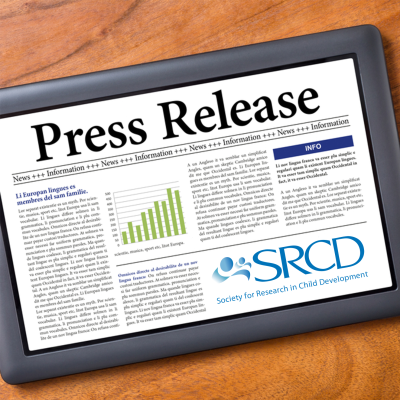The Quality of Parent-Infant Relationships and Early Childhood Shyness Together Predict Teen Anxiety
PRESS RELEASE / CHILD DEVELOPMENT: Embargoed for Release on December 18, 2014
Infants who frequently react to unfamiliar objects, people, and situations by becoming afraid and withdrawing are referred to as having a behaviorally inhibited temperament. As these infants grow up, many continue to be inhibited or reticent when they experience new things, including meeting new people. Inhibited children are more likely than their peers to develop anxiety problems, especially social anxiety, as they get older. A new longitudinal study has found that behavioral inhibition that persists across early childhood is associated with social anxiety in adolescence, but only among youth who were insecurely attached to their parents as infants.
Social anxiety disorder is one of the most common psychiatric disorders among children and adolescents, with rates of about 5.5 percent among 13- to 18-year-olds.
The study was done by researchers at the University of Maryland in collaboration with researchers at the National Institute of Mental Health and the University of Waterloo. It appears in Child Development, the journal of the Society for Research in Child Development.
The researchers studied 165 European-American, middle- to upper-middle-class adolescents (ages 14-17 years) who were recruited as infants (at 4 months). At 14 months, infants and their parents were observed in the lab to see how the babies responded to brief separations from their parents. Infants were classified as having a secure or insecure attachment (to their parent) based on this observation. Securely attached infants initiated contact with their parents after separation and, if they had been upset, they could calm down when their parents returned. Insecurely attached infants showed one of two patterns: Either they ignored or avoided contact with their parents after being separated, or they wanted to be physically close to their parents but were angry and unable to calm down when their parents returned.
Children’s behavioral inhibition and social reticence was observed in the lab as they encountered new situations and new peers several times across early childhood (at 14, 24, 48, and 84 months). Parents also completed questionnaires about their children’s behavior in new situations and with unfamiliar peers. Based on the lab observations and results from parents’ questionnaires, the researchers classified children according to how inhibited or shy they were over time.
Years later (when the children were 14 to 17 years old), participants and their parents completed questionnaires about the adolescents’ anxiety. Youth who said that they often felt nervous going to parties, dances, or other places where there would be people they didn’t know well, and often felt nervous when they had to do something in front of an audience like read, speak, or play a game or sport, scored higher on social anxiety than youth who said they had such feelings less frequently.
The study found that children who were both insecurely attached to their parents as infants and who were inhibited throughout their childhoods went on to have higher levels of anxiety as adolescents, specifically social anxiety. Teen males who were insecurely attached to their parents as infants and who were inhibited across early childhood were at the most risk for social anxiety. In addition, the association between childhood inhibition and adolescent social anxiety was strongest for children who reacted angrily and weren’t able to calm down when reunited with their parents (during the lab task at 14 months), compared to children who showed other types of attachment patterns as infants.
Previous studies have examined either infant attachment or behavioral inhibition as risk factors for anxiety separately, but not both risk factors together. And most past studies collected data at only one time or relied only on information from questionnaires instead of observations. “Our study suggests that it is the combination of both early risk factors that predicts anxiety in adolescence, particularly social anxiety,” according to Erin Lewis-Morrarty, research associate at the University of Maryland, who was involved with the study. “The findings can inform the prevention and treatment of adolescent social anxiety by identifying specific factors that increase risk for this outcome among children who are persistently shy.”
The study was funded by the National Institute of Mental Health and the Eunice Kennedy Shriver National Institute of Child Health and Human Development.
###
Summarized from Child Development, Infant Attachment Security and Early Childhood Behavioral Inhibition Interact to Predict Adolescent Social Anxiety Symptoms by Lewis-Morrarty, E, Degnan, KA, Chronis-Tuscano, A (University of Maryland), Pine, DS (National Institute of Mental Health), Henderson, HA (University of Waterloo), and Fox, NA (University of Maryland). Copyright 2014 The Society for Research in Child Development, Inc. All rights reserved.


